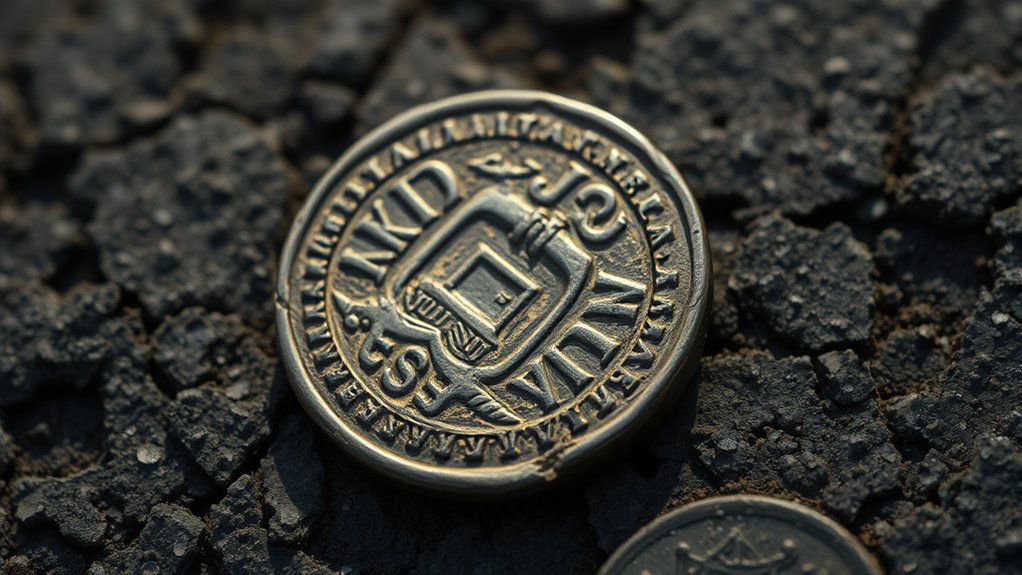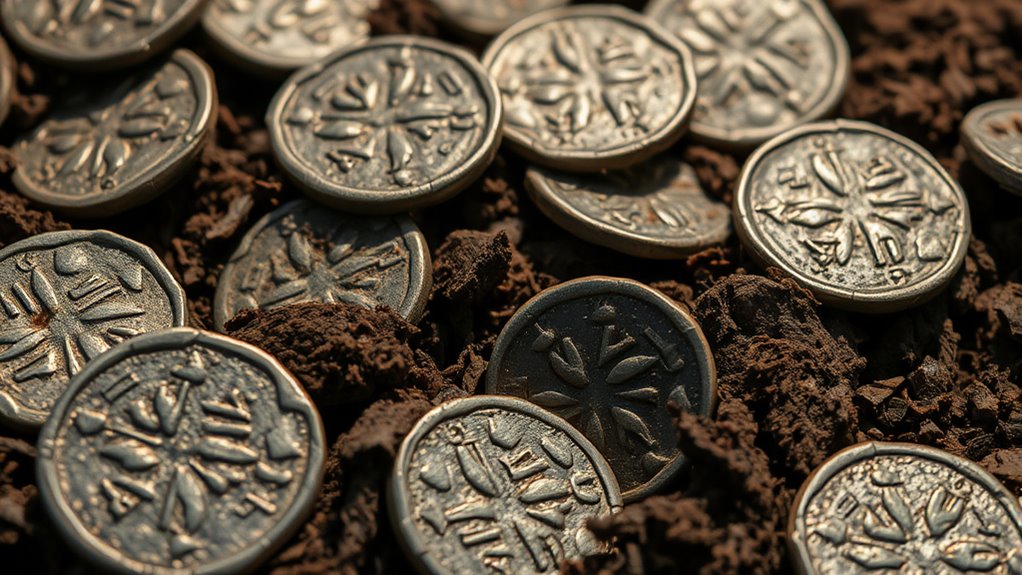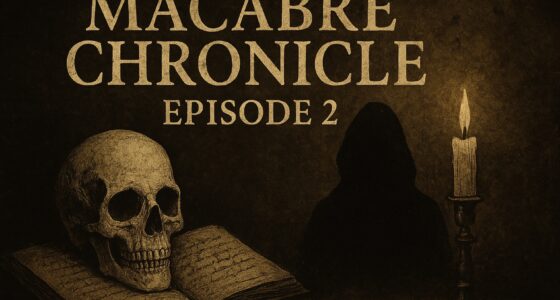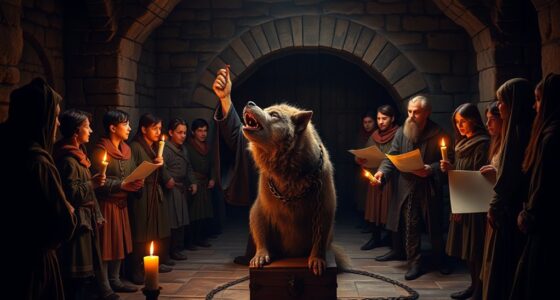Charon’s obol, or burial coins, come from ancient customs where coins were placed with the dead to pay the passage to the afterlife, especially in Greek and Roman cultures. These coins symbolize a fare for Charon, the mythological ferryman, ensuring the soul’s smooth journey across the River Styx. Their placement and significance reflect deep-rooted beliefs about death and progression. To discover the origins and deeper meanings behind these coins, continue exploring this fascinating tradition.
Key Takeaways
- Charon’s obol is a coin placed with the deceased to pay the mythological ferryman for crossing the River Styx.
- Burial coins originated in ancient Greek and Roman practices, symbolizing safe passage and transition to the afterlife.
- The practice reflects cultural beliefs that coins serve as offerings or gifts to honor the dead and ensure their journey.
- Variations in coin material and placement highlight differences in societal values and rituals across cultures.
- The symbolism of Charon’s obol continues to influence modern concepts of death, remembrance, and spiritual transition.

In many ancient cultures, placing coins with the dead was believed to guarantee safe passage to the afterlife, a practice rooted in myth and tradition. This act wasn’t just about tradition; it held deep mythological symbolism, representing a payment or fare for the journey beyond the mortal sphere. You might encounter this custom in Greek, Roman, and other ancient civilizations, where it served as a crucial element of their funerary practices. The coins, often called burial or funeral coins, were thought to ensure that the soul could cross the boundary between life and death smoothly, avoiding the perilous obstacles that awaited unprepared travelers.
The practice of placing coins with the deceased is closely linked to the figure of Charon, the mythological Greek ferryman who transported souls across the River Styx into the Underworld. The term “Charon’s obol” specifically refers to the coin used for this passage. Symbolically, these coins represented more than just payment; they embodied the idea of transition and the hope for safe passage in the afterlife. You can see how ancient funerary practices integrated these coins into rituals, emphasizing their significance in spiritual journeys. The belief was that without this coin, the soul might be stranded or doomed to wander, highlighting the importance of mythological symbolism in shaping their understanding of death and the afterlife.
Over time, these coins took on varied forms and values depending on the culture and era. In Greece, for instance, small bronze or silver coins were placed in the mouth or on the eyes of the deceased. In Rome, similar customs persisted, reflecting the widespread belief that coin offerings were essential for ensuring peaceful passage. You might notice that these coins also served as an expression of respect or a gift to the dead, reinforcing societal values about honoring ancestors and facilitating their transition. Their placement was often accompanied by specific rituals, underscoring the deeply ingrained nature of these practices in ancient funerary traditions. Additionally, these customs reveal the importance of cultural beliefs in shaping attitudes toward death and the afterlife.
Ancient coins in funerary rites symbolized respect, transition, and societal honoring of the dead through ritual placement.
Today, the symbolism of burial coins continues to influence modern interpretations of death and remembrance. While the actual practice of placing coins may have faded, the underlying mythological symbolism remains powerful, reminding us that many cultures historically viewed death as a journey that required preparation and offerings. These ancient funerary practices reveal how intertwined myth, ritual, and belief are in shaping human responses to mortality. Ultimately, the coins served as more than mere objects—they were a bridge between worlds, embodying hope, transition, and reverence for life’s final passage.
Frequently Asked Questions
How Did the Practice of Placing Coins in Graves Spread Geographically?
You see, the practice of placing coins in graves spread through trade routes, which facilitated cultural diffusion across regions. As traders and travelers moved between communities, they shared customs, including burial practices, leading to widespread adoption. Over time, this tradition became integrated into various cultures, adapting to local beliefs and practices. So, the movement of goods and ideas along trade routes played a vital role in spreading this symbolic custom globally.
Were Burial Coins Used in Cultures Outside of Ancient Greece and Rome?
You’ll find burial coins used beyond Greek and Roman traditions, appearing in about 15 different cultures worldwide. These non-Greek, Roman cultures often incorporated ritualistic offerings in their burial practices, including coins or similar objects. For example, in ancient China, small tokens were buried with the dead to guarantee safe passage to the afterlife. This shows how diverse societies adopted similar customs for spiritual or ritualistic reasons, emphasizing their universal significance.
What Materials Were Most Commonly Used for Burial Coins Across Different Eras?
You’ll find that burial coins across different eras mainly used metals like silver, bronze, and copper. Metal composition varies due to regional differences, with Greek and Roman cultures favoring silver and bronze, while other regions used more copper. These regional variations reflect local resources and trade, influencing the choice of materials. Coins were often chosen for their durability and symbolic value, ensuring they served their purpose in the afterlife.
Did the Size and Shape of Burial Coins Vary Significantly Over Time?
You might think burial coin size evolution stayed consistent, but it actually varied quite a bit. Over time, burial coin shape shifted from small, round tokens to more diverse forms, reflecting cultural and regional differences. This variation helped maintain the coin’s symbolic purpose, ensuring it served its role in guiding souls. So, yes, the size and shape of burial coins changed markedly, adapting to the beliefs and practices of each era.
Are There Any Modern Practices That Resemble Ancient Coin Offerings in Funerary Rites?
Modern monetary rituals and contemporary funerary customs sometimes resemble ancient coin offerings. You might see families placing coins on graves or including money in coffins, symbolizing passage or protection. These practices reflect a continued belief in money’s spiritual significance, echoing past traditions. While the specifics vary, the essence remains: money serves as a symbolic gift for the journey beyond, linking current rituals with age-old beliefs about life, death, and the afterlife.
Conclusion
Understanding Charons Obol and burial coins connects you to ancient beliefs about the afterlife. Did you know that over 60% of burial sites across Europe contained coins, highlighting their importance? These coins weren’t just valuables; they symbolized passage and protection for the journey beyond. Next time you see a coin, imagine it’s part of a centuries-old tradition helping souls cross into the next world—an enduring reminder of humanity’s timeless hopes and rituals.









